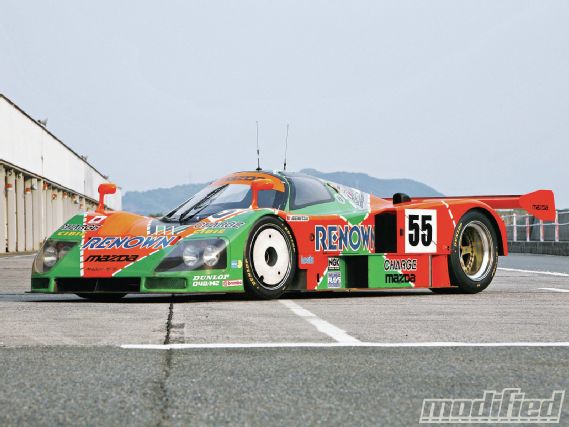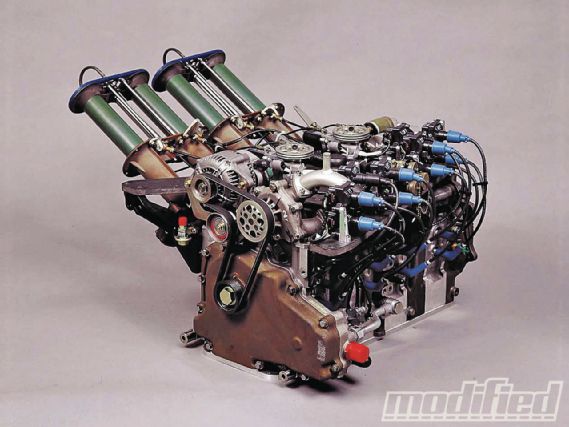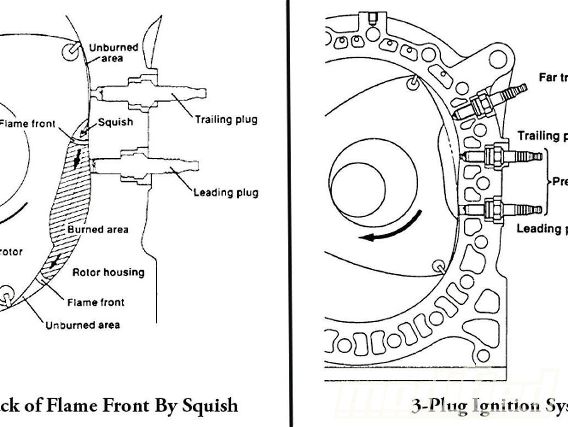 More Rotors, More Better - Tech Talk
More Rotors, More Better - Tech Talk
OK, I’ll admit it — I’ve become a bit obsessed with rotary engines, no doubt because of Project RX-8 and the Renesis 13B engine build we’re in the midst of. But no matter how much power we’re able to squeeze from our Renesis, as the saying goes, “There’s no replacement for displacement,” so I can’t help but fantasize about stuffing a 4-rotor under the hood of the 8 once we’ve fully explored the potential of the 2-rotor 13B.
 |
Mazda’s 787B is still the only Japanese sports car to win the 24 Hours of Le Mans.
|
Mazda’s 787B is still the only Japanese sports car to win the 24 Hours of Le Mans.
My rotary obsession was given even more fuel recently, thanks to Mazda dusting off its old Le Mans–winning 787B sports car prototype to turn a few demo laps in celebration of the 20th anniversary of the historic feat in 1991. To this day, Mazda’s victory at Le Mans makes it the only Japanese automaker to have won this oldest and most prestigious sports car endurance race, not to mention being the only non-piston engine to have claimed victory.
Although rotary engines aren’t exactly famous for their durability or fuel efficiency, Mazda’s engineers threw every trick in the book (and added a few new ones) when designing the awesome R26B 4-rotor engine that powered the 787B to the top step of the podium, never missing a beat during 24 hours of wide-open-throttle abuse around Circuit de la Sarthe. This cutting-edge 4-rotor powerplant, which produced almost 700 hp at an astronomical 9000 rpm, wasn’t just about power, though; to win at Le Mans, you also need reliability and fuel efficiency, and Mazda took these variables very seriously when designing the R26B.
Featuring a number of truly innovative technologies designed to enhance power output, fuel efficiency and reliability — most notably, a three-piece eccentric shaft, a continuously variable telescopic intake manifold, peripheral port injection, a third spark plug on each rotor, two-piece ceramic apex seals, and a cermet (a composite material composed of ceramic and metallic materials) coating on the mating surface of the rotor housings — the R26B is truly a masterpiece of rotary engine design.
 |
The R26B was (and still is, in many ways) a marvel of technological advancement, some of its design elements making it into later production-version rotary engines.
|
The R26B was (and still is, in many ways) a marvel of technological advancement, some of its design elements making it into later production-version rotary engines.
On the induction side, this hugely efficient 2.6-liter rotary engine used peripheral ports for improved volumetric efficiency, with a sliding throttle valve for low restriction in wide-open-throttle operation (especially important at Le Mans with its very long straights). But what was truly unique was its telescopic intake manifold system, the first of its kind ever used on a racing engine. This system, controlled by the ECU, steplessly varies the intake pipe length so that it matches the engine speed, providing a dynamic effect over a wide rpm range (varies from its most extended position to the shortest between 6000 and 8500 rpm). The intake pipes were extended to bring in the torque peak at a lower engine speed, sliding across its 175mm range such that peak torque could be delivered anywhere between 6250–8250 rpm.
The overall effect of this unique intake system was a very flat torque curve, especially across the 6000–9000 rpm operating range of the engine during the race.
Taking full advantage of the peripheral port design of the R26B meant using peripheral port fuel injection (PPI), rather than the standard AFI (air funnel injection) used on rotary engines up until this point. By locating the injectors close to the intake port opening in the rotor housings, delays in fuel delivery were minimized, resulting in significantly improved throttle response and considerable improvement in fuel consumption. Reduced fuel consumption, particularly at wide-open throttle, was the result of enhanced air/fuel ratio controllability and the resulting expanded fuel-cut zones.
On the ignition side of the equation, Mazda added a far trailing spark plug to each rotor (for a total of three plugs per rotor), the result of which was improved combustion and fuel efficiency. With the conventional two-plug system, the flame front within the combustion chamber doesn’t spread to the trailing end in the mid- to high-rpm range. As a result, the mixture in this “squish” area at the trailing end of the chamber is expelled in an unburned state. By adding a third plug to the R26B at the far trailing end of the combustion chamber in each rotor, the air/fuel mixture is ignited before any squish is generated, causing the mixture to burn completely, resulting in a faster moving flame front and markedly improved fuel consumption, along with some improvement in power output.
 |
With a typical two-plug ignition system, squish (left) causes the flame front to be pushed back, leaving some of the air/fuel mix unburned. A three-plug approach (right) helped eliminate this problem on the R26B, improving power output and fuel efficiency.
|
With a typical two-plug ignition system, squish (left) causes the flame front to be pushed back, leaving some of the air/fuel mix unburned. A three-plug approach (right) helped eliminate this problem on the R26B, improving power output and fuel efficiency.
Inside the R26B, the apex seals and rotor housing mating surfaces received special attention as well, ensuring maximum durability and engine output. As Mazda’s R&D revealed, the carbon apex seals the company had used on previous racing engines wouldn’t have sufficient strength for the power the R26B would produce, so Mazda went back to the drawing board to cook up a special ceramic two-piece seal capable of providing the high levels of strength and wear resistance required for a race as grueling as Le Mans.
To determine what ceramic material to use, sliding properties, flexural strength and a number of other variables were tested using a rig, resulting in a silicon-nitride based material being chosen for this very special engine. The seals were also fiber-reinforced for added toughness and strength, while short-fiber, silicone-carbide whiskers were used to provide fracture toughness and wear resistance. This tough seal material paved the way for two-piece apex seals in Mazda’s production engines, not to mention its gas sealing was so good that torque production actually increased compared to the old one-piece seals.
Meanwhile, the mating surface within the rotor housings — where considerable wear would result from the apex seals, side seals and oil seals sliding at high speed and high load — were coated with chrome-carbide base cermet. This coating was designed to increase wear resistance and reduce friction (and thus increase engine reliability), particularly in a high-temperature environment like a rotary engine screaming at 9000 rpm.
Results don’t lie, so clearly Mazda’s engineers did a world-class job designing the R26B 4-rotor engine. Just as remarkable as the 787B’s win at Le Mans was the engine-teardown results after the race, which showed virtually no deterioration. Wear of the apex seals, rubbed surfaces of the housings and bearings were all found to be half or one-third the upper limits of tolerance, demonstrating the remarkable durability and reliability of this engine.
Which brings me back to my 4-rotor engine swap fantasy for Project RX-8. Just how feasible is this swap anyway? Well, as BMI Racing has proved with its 4-rotor Formula D RX-8, where there’s a will there’s a way. There are 4-rotor crank kits available from shops like Kiwi-RE and Pulse Performance Race Engineering (the madmen behind Mad Mike’s 4-rotor FD RX-7), but be warned: these kits are far from cheap, and there are lots of other parts that need to be sourced and sorted before you’ve got a running 4-rotor (not the least of which are custom engine mounts, wiring, engine management and intake and exhaust manifolds).
Of course, for a cool $67,000 New Zealand dollars (about $54,000 USD), you can buy a full 4-rotor engine package from PPRE, including manifolds and a wired ECU, so then all you have to do is figure out how to mount it in your car. Not for the faint of heart or limited of bankroll, but a seriously badass powerplant if you’ve got the means to make it happen.
For inspiration, jump on YouTube and search for videos of Mad Mike’s RX-7 and BMI’s RX-8 — both produce a sound that’s guaranteed to give you goosebumps.
 |
More Rotors, More Better - Tech Talk
|
More Rotors, More Better - Tech Talk
Send your feedback to [email protected]
R26B Engine Specs
Category
Type
Cylinder arrangement
4-rotor inline
Displacement (cc)
654 cc x 4-rotor
Eccentricity x generating radius x width (mm)
15 x 105 x 80
Compression ratio
10.0
Intake porting
Peripheral porting
Maximum output ( kW/rpm)
515 kW / 9000rpm
Maximum torque (N . m/rpm)
608 N . m / 5600rpm
Weight (kg)
180
Fuel supply system
Electronic controlled fuel injection
Induction system
Telescopic intake manifold system
Lubrication system
Dry sump
Cooling system
Water cooling
Ignition system
Electronically controlled CDI
